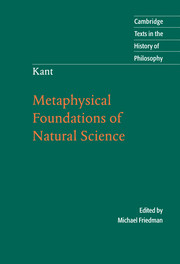Book contents
- Frontmatter
- Contents
- Acknowledgments
- Introduction
- Chronology
- Further reading
- Note on texts and translation
- Metaphysical Foundations of Natural Science
- Preface
- First Chapter Metaphysical Foundations of Phoronomy
- Second Chapter Metaphysical Foundations of Dynamics
- Third Chapter Metaphysical Foundations of Mechanics
- Fourth Chapter Metaphysical Foundations of Phenomenology
- Glossary
- Index
- Cambridge Texts in the History of Philosophy
Fourth Chapter - Metaphysical Foundations of Phenomenology
Published online by Cambridge University Press: 05 June 2012
- Frontmatter
- Contents
- Acknowledgments
- Introduction
- Chronology
- Further reading
- Note on texts and translation
- Metaphysical Foundations of Natural Science
- Preface
- First Chapter Metaphysical Foundations of Phoronomy
- Second Chapter Metaphysical Foundations of Dynamics
- Third Chapter Metaphysical Foundations of Mechanics
- Fourth Chapter Metaphysical Foundations of Phenomenology
- Glossary
- Index
- Cambridge Texts in the History of Philosophy
Summary
Explication
Matter is the movable insofar as it, as such a thing, can be an object of experience.
Remark
Motion, like everything that is represented through the senses, is given only as appearance. For its representation to become experience, we require, in addition, that something be thought through the understanding – namely, besides the mode in which the representation inheres in the subject, also the determination of an object thereby. Hence the movable, as such a thing, becomes an object of experience, when a certain object (here a material thing) is thought as determined with respect to the predicate of motion. But motion is change of relation in space. There are thus always two correlates here, such that either, first, the change can be attributed in the appearance to one just as well as to the other, and either the one or the other can be said to be moved, because the two cases are equivalent; or, second, one must be thought in experience as moved to the exclusion of the other; or, third, both must be necessarily represented through reason as equally moved. In the appearance, which contains nothing but the relation in the motion (with respect to its change), none of these determinations are contained. But if the movable, as such a thing, namely, with respect to its motion, is to be thought of as determined for the sake of a possible experience, it is necessary to indicate the conditions under which the object (matter) must be determined in one way or another by the predicate of motion.
- Type
- Chapter
- Information
- Kant: Metaphysical Foundations of Natural Science , pp. 93 - 104Publisher: Cambridge University PressPrint publication year: 2004

